Waldorf News
Waldorf Education Blossoms in the Andes
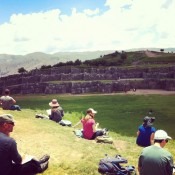
By NINA PICK
Humanities Teacher, Marin Independent High School
The students of Marin Independent High School, a young high school initiative associated with the Marin Waldorf School, recently went on a trip to Pisac, Peru as part of their Ancient Civilizations main lesson block led by Ken Smith. Pisac is a village in the Sacred Valley of the Incas where the students—along with Ken, myself, and MIHS co-founder Megan Neale—spent almost two weeks visiting and sketching ancient ruins, learning about pre-Columbian history and indigenous culture, and volunteering at Kusi Kawsay, a bilingual Spanish-Quechua school that combines Waldorf pedagogy and traditional Andean practices.
We also had the opportunity to work side-by-side with a group of 17-year-old Kusi Kawsay alumni on the small permaculture farm they had started as a school project. We found that Pisac was an ideal site at which to locate our main lesson, as much of the traditional indigenous culture—from the Quechua language, to agriculture, to arts such as weaving and dancing—is alive and thriving, so that the study of Ancient Civilization became enlivened by such vibrant experiences as visiting the traditional farming community of the Amaru or learning about pre-Colombian astronomy while standing in the ruins of an enormous Incan calendar. Here, in excerpts from essays they completed upon returning home, the students of MIHS share their experiences, reflections, and questions inspired by the trip.
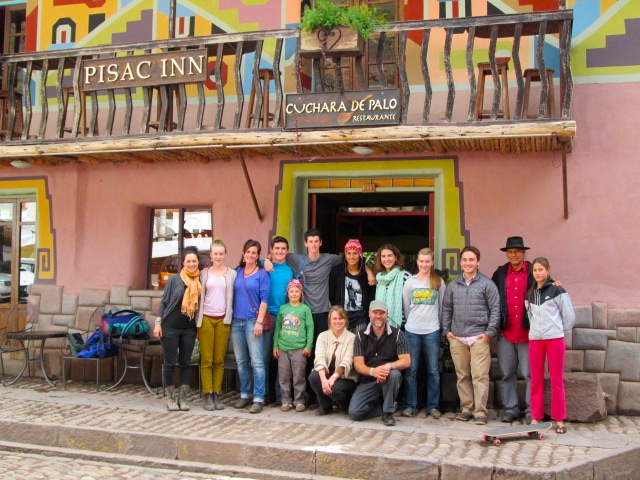
MIHS students and teachers with our hosts, the Vizcarra-Wood family
While I was working on the Kusi Nan Farm Project I was amazed by the harmony of the farm. Kusi Nan Organic Farm was started, owned and run by the graduating class of Kusi Kawsay School. The students are only one to three years older than me—yet I still have two more years of high school and then I am expected to attend another four years of college.
They may not be lawyers or doctors, but they have a livelihood and are doing something fruitful with their lives. When I mentioned this to some friends back in California they told me I must have realized how lucky I was to have school. To be honest that thought never crossed my mind. I was almost envious of the working students. I know I am fortunate to be given the opportunity to go to high school and college, but going to school for twelve years straight is a little repetitive.
For me, it was refreshing to see something alternative and healthy. Instead of waking up every morning to go sit inside in a classroom the students from the farm wake up to work outdoors. Being in the moment, on the farm, some might agree with me that it was inviting to stay and spend the rest of one’s time working on the farm.
The farm is at 10,000 feet and is surrounded by the beautiful Andean mountains . Two large boulders sit in the middle of the fields dividing them in half. Just up the mountain you can see Kusi Kawsay School. It was impressive to see how well the working students communicated and worked together.
Each morning we gathered and chewed coca leaves while they discussed what we were going to work on that day. How did they learn to take care of a farm? Over time I learned that it was through experience and mentoring. The first morning I spent weeding. To spend a morning weeding, crouching in the soil, is relaxing and somewhat mesmerizing. I found myself thinking of old memories or composing short sentences in my head in Spanish. Other times I just thought about weeding.
The next morning we hiked up the mountain behind the farm to cover their new water tank. At this high altitude, just walking a couple hundred yards up a steep incline and I was quite out of breath. Around me, the students were already at the water tank, waiting as if they had just taken a stroll. They had recently finished installing the water tank and they wanted to cover the pipes to protect them. I thought we were going to cover it with dirt, but looking around I saw that there was not much dirt to spare. Instead we used the rocks around us to make a wall and then covered the pipes with the spikiest plants we could find—now no one could touch it.
Each day, since I have returned from Pisac, Peru I think about the farm and the wonderful people I worked with. I love to be outdoors, and to work in such a beautiful, special place was quite a treat. I think that I now have a connection there in Pisac, and I hope to continue to cultivate that connection and friendship. —Fielding Neale, 16
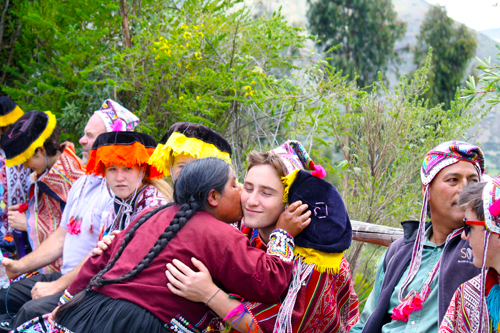
A MIHS student is welcomed at the Amaru Community
Last month our school went on a trip to Peru. Our main focus for the trip was to see many different archeological sites, including Machu Picchu. It was such an amazing experience; I loved how different it was compared to the U.S. The Peruvians weren’t as technologically advanced as the U.S., but the differences lie specifically in how the people there interact with each other. The people in Peru all give hugs to everyone, and kisses on the cheek.
Here, as one walks down the street, people don’t even acknowledge that someone is there. They’re focused on texting their friend that lives in the house next door. Also, we each live in expensive homes and in squares of land where each house sits in the middle almost quarantined from anything else. Most towns are built like this. It is nice to have some land around each house to have a garden or privacy, but it ruins the sense of being together with others.
In Pisac the layout of the buildings was somewhat different than in Northern California. In the actual town, buildings were compact to conserve space, and in most of the landscape, people’s houses were near each other where they could easily come and work together and be with their friends.
In the Amaru weaving community in the higher mountains, they live all together in their huts and mud brick houses over a large expanse of land with livestock and crops. They live pretty close to each other, and they work together all of the time. Each family has sections of land all over their whole territory in the mountains. When one of the pieces of land needs to be tilled or planted, the owner invites lots of people to come help and do work on his land. He serves them all food, and they all do the work that needs to be done. The Amaru love this because it’s a big party for them. They all get to talk and work together for hours. Why is this not the same here in the U.S.?
Community is important to me. I need to be with my friends and family to have a good time. Not being with other people really just doesn’t work for me because we were made to be with each other. Maybe sometimes we need to be alone, but in the big picture, we were supposed to live in villages where everyone works together and shares stories together. That is community. It is ever so rapidly falling apart in the U.S. and the fact is really saddening. It was hard for me to notice that there isn’t much community because I haven’t been out of the U.S. before. This first chance for a difference has really opened my eyes and let me think on what life is really about. —Grayson Hamilton-Roth, 16
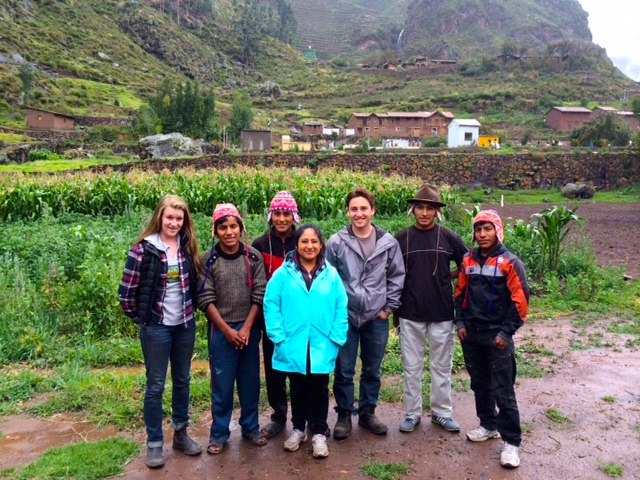
Students working at Kusi Nan Farm
As a kid today I look at our generation and generations before us and realize that we are slowly pulling away from each other. Just recently I went on a trip to Peru and saw how the community worked there. I realized that in the U.S. there are two main sources that I believe are deteriorating our community as a country: technology and ease of accessibility.
If you walk through any great city in the States you will see three out of five people looking at their phones. No one ever has a real interaction anymore. If you go hungry you can drive by a store and pick up a snack, or just order a pizza. We don’t have any conception of where this food comes from. Now of course all people are not like this; in fact I’m lucky enough to know a lot of people who are conscious about everything that goes on around the world, and they live their lives simply. For example, one of my good friends does not have a cell phone; he has no money, but he lives on his sailboat and does odd jobs and makes the best out of it. Then he sails to Hawaii or wherever he wants. He is one of the happiest people I know, and yet no one is perfect.
I bring Peru up because it is a reflection. If you look at a fellow man or women from Peru or anywhere around the world, you will feel a difference. The difference could be huge or small but in the end you cut straight to the point: he or she is a human being like you. The only thing that makes you different is your environment. Your environment is often the seed of yourself. Not only does the environment create who you look like on the outside, it creates who you are inside. I’m not saying that everyone is related but I’m saying we all breathe air and follow the same generic code.
When I was in Peru I saw that most people were happy with their lives. They live primitively, grow their own food, and have no car or motorcycle. They do a lot of walking. They consider most work to be fun because they talk and joke around and make it enjoyable. As I walked down the street, I would see an old man sitting in a doorway, just sitting there and enjoying himself watching the clouds. I would think to myself, “Okay, you don’t see that everyday,” but in Peru every other house had someone just relaxing. I would continue walking and come back a few hours later, and he would still be relaxing in the same spot.
I also noticed that when you greet a man you give him a hug and if you were greeting a women you give her a hug and a kiss on the cheek. No matter if you had never met this person before, you always give a hug and a kiss depending on the gender.
The more I think about it, it’s all the little things we don’t do here in the U.S. that let us drift farther apart from each other. Living in the States I’ve always noticed how most people are very, very slowly losing their communication skills, and from what I see everyday I would blame TVs, phones and computers. And don’t get me wrong, I love my phone and other technology, except TV, which is a little boring. It is sad for me, though, because I know that phones, computers and other technologies cause depression, which leads to more depression.
I think the term “chain reaction” is key for this whole idea that I’m writing about, and my whole goal is to let people know, or remind them, that we don’t have to be so self-conscious about communicating our feelings and wants. If you truly believe in something, no matter where you come from, you can create happiness, even if it seems completely impossible at the moment. The first step is to smile and open your eyes. —Matisse Manuel, 16
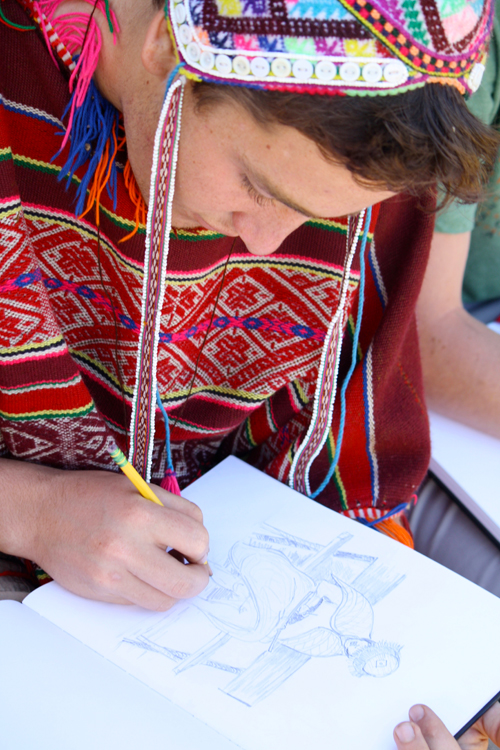
MIHS student Matisse Manuel sketches at the Amaru community
After roughly fifteen hours of travel, I stepped off the van onto the uneven stone streets of Pisac, Peru. Squinting my eyes from the bright sun, I looked around: our van took up most of the street, the gutter ran down the center of the street, and the power lines above were a tangled knot of wires. A nine-year-old boy with a dark brown braid down his back, a colorful knitted cap and a skater t-shirt a few sizes too big was coming around very genuinely but almost robotically giving each of us a kiss on the cheek and welcoming us. He was later introduced as Katari, the son of our host and guide, the Vizcarro-Wood family. This was a surprise to me; he didn’t know our names, yet he felt comfortable or maybe even obligated to welcome us each individually.
Later that night during dinner, more members of the Vizcarro-Wood family came into the restaurant. Suni, the eldest son, and Suni’s friend immediately made the round, kissing the women and offering a handshake to the men. For the rest of the trip this was the greeting for anyone we met, from elders to teenagers and young children. It made me feel part of the community, and it was nice to have a regular greeting.
In the States I feel like there is no real, set greeting; a simple “hello,” maybe a nod of acknowledgement or a brief handshake when introduced, nothing more. I think it can be fine, but it is hard to know which one to do in which situation. It seems to me other cultures, such as the one in Pisac, have a set way: in France (even the children) shake hands and offer a kiss on both cheeks; in Japan a bow; and Russians give a very firm handshake and three kisses to the women. That seems to be a theme in the greetings—a handshake, hug, kiss; for the North Americans the question seems to be, “How do I know which to use?” Our greeting seems to be a mush of everyone else’s.
A few days later we visited an ancient site named Saqsayhuaman. While admiring the incredible stonework Román, our guide and a Quechua Indian, brought our attention to the way the stones were carved and put together. “Joined like a community” he said. “The stones are carved just enough so that they will work together but are still individual. Not like bricks.” This got me thinking: the small mountain communities worked and shaped themselves like the stonework. They come together in a consistent way. The rocks are perfectly carved and still manage to be amazing on their own, individually. This is how I felt about the people of Pisac, Peru. —Lily Neale, 16

MIHS students sketching at Sacsayhuaman
During my recent class trip to Peru I was fortunate enough to visit the Kusi Kawsay Waldorf School. For a small amount of time I was able to observe their daily school life and immerse myself in their culture. A very special part of this school is that it combines the Waldorf education with their local Andean traditional ways of living. At first this surprised me as it was different from the way that I was educated in a Waldorf school. But then I understood what they were doing. At this school they are leading the way for the future of Waldorf schools around the world.
I have been in a Waldorf school in northern California almost my entire life, but was also fortunate to experience Waldorf education in Bologna, Italy for three years in the lower grades. I noticed many similarities between the two schools and after visiting Kusi Kawsay,
I noticed that students in all three schools recited the verse, “I look into the world, in which the sun is shining, in which the stars are sparkling…” But the difference between the schools I have attended in the past and Kusi Kawsay was that while these students are being taught according to the fundamentals of Waldorf education, they are also learning about the indigenous ways and history and are gaining an understanding of the importance of elders in their community. The students learn songs and sayings in Quechua, the ancient language of the Andes. The school and many of the students follow the Andean Agrarian calendar that is formed with the natural cosmic cycles.
To me this is progress; this is the future. Rudolf Steiner himself formed a school for Germany in 1919. He created a curriculum to suit what the children needed at that time. Now in 2014, Steiner’s ideas remain, but our needs are different. Waldorf schools should adapt to their location and their students’ individual needs. Steiner wanted development and that is why he made his school
Let us do the same; let us advance. The root is there for us to grow on, but it is not necessary to do so in an identical fashion. Being different is important, and now that I have experienced Waldorf education in Peru, I can appreciate my own experimental Waldorf high school to a greater level. I now know experiments are being made across the globe, and Kusi Kawsay is one that is succeeding. —Nyracai J. Davis, 16
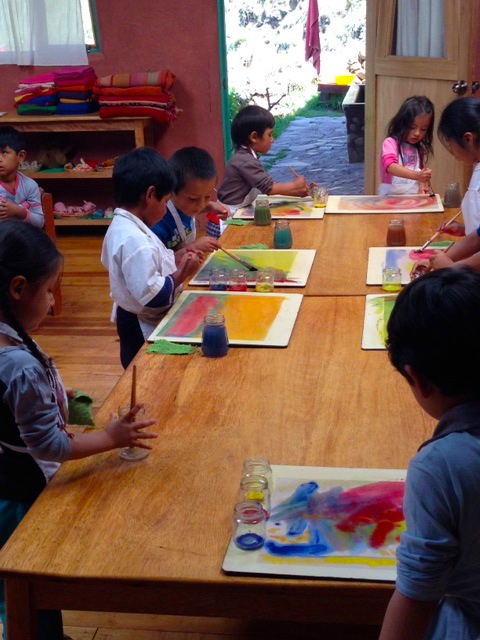
Painting day in the Kusi Kaway kindergarden
A version of this article was first published in the Point Reyes’ Light. Thank you to the Light’s editor, Tess Elliott.
For more information about Kusi Kawsay, visit kusikawsay.org. The school welcomes financial support, as well as gifts of Waldorf arts supplies. It also welcomes inquiries from individuals interested in visiting or volunteering.
Learn more about MIHS at facebook.com/MarinIndependentHighSchool or contact Megan Neale at mneale@horizoncable.com.
 Everything a Teacher Needs
Everything a Teacher Needs Caring for All Stages of Life
Caring for All Stages of Life Flexible preparation for your new grade
Flexible preparation for your new grade Waldorf Training in Australia
Waldorf Training in Australia Middle School Science With Roberto Trostli
Middle School Science With Roberto Trostli Apply Today: New Cohort Starts Nov. 2025
Apply Today: New Cohort Starts Nov. 2025 Bay Area Teacher Training
Bay Area Teacher Training Summer Programs - Culminating Class Trips
Summer Programs - Culminating Class Trips The Journey is Everything
The Journey is Everything Jamie York Books, Resources, Workshops
Jamie York Books, Resources, Workshops Great books for Waldorf Teachers & Families
Great books for Waldorf Teachers & Families Space speaks. Its language is movement.
Space speaks. Its language is movement. Transforming Voices Worldwide
Transforming Voices Worldwide Quality Education in the Heartland
Quality Education in the Heartland Roadmap to Literacy Books & Courses
Roadmap to Literacy Books & Courses Immersive Academics and Arts
Immersive Academics and Arts Train to Teach in Seattle
Train to Teach in Seattle Bringing Love to Learning for a Lifetime
Bringing Love to Learning for a Lifetime Association for a Healing Education
Association for a Healing Education ~ Ensoul Your World With Color ~
~ Ensoul Your World With Color ~
 Full-Time Teacher Education
Full-Time Teacher Education Waldorf-inspired Homeschool Curriculum
Waldorf-inspired Homeschool Curriculum RSS Feeds
RSS Feeds